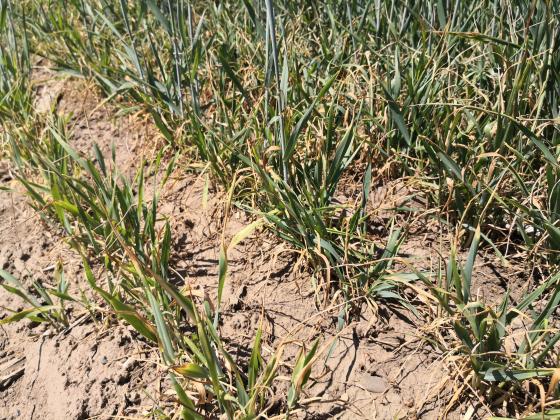Rachael Brooke - Phillips-Rooks District Extension Agent, Agriculture and Natural Resources
The potential for high nitrate concentrations in crops such as cereal grains (including wheat) corn, sorghum, canola, and some grasses occurs after exposure to drought, hail, frost, cloudy weather, or soil fertility imbalance. Nitrates accumulate in the lower portion of these plants when stresses reduce crop yields to less than expected, based on the supplied nitrogen fertility level. Feeding harvested forages or grazing plants that are high in nitrates can be toxic to livestock because the metabolism products from nitrates interfere with the ability of blood to carry oxygen, causing asphyxiation.
Due to prolonged extreme drought conditions, many wheat stands across Kansas are thin and short this year. Some producers are making the decision to graze out or hay their wheat due to very low yield potential. Under certain environmental conditions, cereal grains like wheat and oats can accumulate potentially toxic nitrate levels. Keep in mind that nitrate levels can increase in drought-stressed plants after a rain event.
It is wise for producers to test their drought-stricken forage prior to grazing or feeding hay. Some data suggests nitrates can cause a loss of pregnancy in cattle at levels lower than death loss.
Nitrate testing can be done through several labs, including the K-State Soil Testing Laboratory. Producers should collect a good representative forage sample of what the cattle will graze or above the cutting height if mechanically harvesting to accurately determine the nitrate concentration.
Many of these stressed wheat fields are very low on biomass. Producers need to be careful not to remove too much material otherwise the field could be susceptible to wind erosion. In addition, short-duration grazing due to low plant biomass could cause issues maintaining a consistent diet and minimizing bloat for newly weaned calves or maintaining a consistent diet for conditioning cattle for breeding. The wheat intended for grazing is high in crude protein and energy and is an excellent feed resource during this drought period.
For more information, please contact the local K-State Research and Extension Office.
K-State Research and Extension is an equal opportunity provider and employer.

